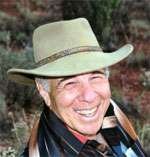 By Mel Copen
By Mel Copen
Sedona AZ (January 24, 2012) – In addition to the monthly Big Park Council President’s letter that I have been writing for the “Villager” for the last two years, I also write a bi-weekly column (now in its 13th year) that is carried on web sites here inArizona, in Georgia (where we have a second home) and on many sites. The articles for the “Villager” have been specifically oriented to the Village and the greater Sedona Area. The others deal with broader issues and have not been community specific.
This one departs substantially from prior patterns. First, I am combining the two columns into one. Second, it deals with a specific community, starting with the greater Sedona area, extending to Cottonwood and then up to Flagstaff (call it Northern Arizona). For medical support, one can think of this as an integrated delivery system. Third, it is much longer than usual. And fourth, I have used the names of actual people and organizations – both to express my gratitude and admiration and because it will make things much clearer, especially to those readers who live inNorthern Arizona
Finally, in one sense it is highly personal, but although I am the main character, the theme is not about me. It’s about people and specifically, friends and neighbors, doctors and nurses. Aside from geographic features, Sedona may not be unique. But it is a very very special place.
The Vision Survey we conducted some time ago, revealed that a key factor in the decision to move to Sedona (aside from the magnificent physical environment) is the people – people with diverse interests who care, who get involved, who create a sense of “community.” This is echoed in many tangible ways throughout the story.
One key issue that was identified in attempting to create a vision for the future was a desire for greater access to medical, and particularly medical emergency services. The idea of anUrgentCareCenteris one that I am sure will emerge as a priority. However, given our size, an emergency room is probably not in the cards (unless some giant health care corporation decides that Sedona would be an attraction for both medical personnel and patients). But there is a system that surrounds us, and it works! In this case, beautifully.
The story began about three months ago. My right shoulder suffers from severe osteoarthritis, and I have been living with pain (but tolerable) for some time. About three months ago I noticed some additional symptoms when I used that arm. I would develop an ache extending from my jaw and extending down my arm and my right side, and I would break out into a cold sweat. These incidents were relatively infrequent and lasted only 10-15 minutes and then I was back to normal. I attributed this to the arthritis and didn’t see it as anything more than curious.
In December, just before leaving on a trip to visit our daughter, Erika, inCoeur d’Alene,Idaho, I spoke with my primary care physician, Dr. Henning Ansorg (of Choices Integrated Health Care) about another health matter, and happened to mention these symptoms. Aside from being a fine physician, Dr. Ansorg is a caring, considerate person whose follow-up has always been impressive. He said, “Let’s be safe.” Within a short period of time I got a call from the Verde Valley Medical Center (VVMC), to schedule a stress EKG and vascular tests aimed at examining blood flow up the carotid artery to the brain. I scheduled them for immediately after our return fromIdaho. As it turned out, I failed on one and passed the other.
Whenever I go to a medical appointment, I usually bring a book. The first surprise I got was that I was met precisely at the designated time – no opportunity to read. The second was the quality and professionalism of the experience. The nurse carefully explained the procedure, anticipating my questions, and in simple language – a person who made it clear that you were her first priority and everything would be done to make you comfortable and satisfy your needs. My anxiety level dropped considerably. The same caring behavior was shown by the technicians and others I met. This experience was duplicated later, when I came back for the vascular tests.
The final surprise was that, in preparation for the EKG, I came dressed in shorts and a t-shirt. But instead of the treadmill or step stool, I was asked to lie down. A slightly radioactive material was injected and readings were taken. Then I was given another substance that essentially dilated the heart arteries, just as if I had been running. This was followed by another injection of radioactive material, to determine the difference. It was the least stressful EKG I’ve ever experienced. This took place on Tuesday, December 27. I was told that the results would be available in two days.
Early Thursday morning the phone rang. It was Dr. Ansorg indicating that he had the results, and there was a problem. He wanted me to go for further testing to narrow the problem down and get it taken care of. He suggested Dr. Bruce Peek, a cardiologist at the VVMC. Of course, I assented. Next surprise, within 10 minutes Dr. Peek was on the telephone setting up the procedure for the following morning. I was amazed at the rapid and personal responses from these two very busy physicians.
We arrived at the VVMC Friday morning. Again, no time to read my book, and once again, the reception process was so efficient and friendly – something that I had begun to suspect existed only at the Mayo clinic. But Mayo’s attention to patient need, comfort and convenience is matched by the VVMC.
Being treated by Dr Peek turned out to be another wonderful experience. He had explained a bit of the procedure over the telephone, and what we hoped was that the angiogram (I may not have identified the procedure exactly, but it’s close) would reveal the blockage, he would insert a stent, and I would be back home that afternoon. It was not to be.
It was fascinating, lying there, looking at a monitor and seeing a catheter in my heart squirting die into the heart arteries and watching the flow. The images struck me as similar to the nightly whether report – with Doppler images moving across the map. Throughout the procedure Dr. Peek explained what was going on. When the test was finished, he called my wife, Beverly, into the room and gave us his summary. This was the shocker – one of the primary arteries feeding my heart had a 98% blockage. A stent would not do. Dr. Peek recommended bi-pass surgery. He suggested several alternatives, but highly recommended Dr. Steven Peterson, a thoracic surgeon at the Flagstaff Medical Center (FMC) Cardio-Vascular Unit. Again, Dr. Peek had made everything so clear, including options, that we had no problem coming to a decision. Here is another extremely capable physician who goes well beyond the standard for caring, explaining, anticipating anxieties and putting one at ease.
Remember, I walked into the test, feeling good. I obviously had been living with this condition for some time, so I suggested that Beverly and I drive up to Flag. Dr. Peek, in a humorous but authoritative manner said “no way.” Within a few minutes, I was on a helicopter, heading north. Lots of tourists take helicopter rides to see the magnificent scenery. Needless to say, on a gurney, I missed the sights. But again, what impressed me was the competence of the crew (pilot and technicians) who accompanied me. By now I had really started to believe that I was in the best of hands.
When we arrived at FMC, they were waiting and I was taken to the Cardio-Vascular ICU (CVICU). If it weren’t for the reason I was there, I would have been delighted. The nurses I met were incredibly competent, and genuinely caring. Here I was a perfect stranger, but the feeling was that I had just entered an extended family.
Dr. Peterson was returning from vacation that same day. One of his associates looked in on me and they decided to postpone the surgery, first until Saturday and then to Monday. Both Beverly and I were concerned, but we were told that a) treating this as an immediate emergency would limit options; b) I still had dye in my heart from the earlier test, and that could cause complications: and c) they could use the time to help adjust all my blood levels to the ideal for the surgical procedure. Generally, they only do emergency surgery on weekends, since staffing is low, and prefer to schedule any that they can during the regular week. So much for New Year’s Eve.
I don’t think I have every seen a doctor so revered by the staff as Dr. Peterson. I had not yet met him, but everyone assured me that he not only walks on water, he can float on air.
When we finally did meet with him, he took the time not only to explain everything that would transpire, but to answer the myriad of questions we had. That was typical of every meeting we had, despite his busy schedule. I later learned that the ICU had instructions to call him at any time if there was a problem with one of his patients. In my case, I know of at least one such call which was made at 2 a.m. Some of the questions duplicated the Q&A we had had with the nursing staff and all the answers were consistent, giving one a great feeling of confidence. By the time our several conversations were finished, between Friday evening and Monday morning, I truly felt relaxed and anxiety free.
I can’t sing the praises of the nursing staff loudly enough. Everyone was caring. It was a team effort. Nurses and technicians would often stick their heads into the room to ask if there was anything they could do to help me or to assist my primary nurse. The entire atmosphere was up-beat, despite the fact that they were dealing with critically ill people.
At one point, the head of nursing came toBeverlyto talk about her experience and how they could make the ICU even friendlier. For example, although the doors were locked they wanted to put up a sign telling visitors that they are welcome to come in and the procedure to do so – and wanted to make sure the emphasis was “we want to make you comfortable” rather than “we have a lock on the door.”
Monday morning came, and I was prepped for surgery. Again, everything was clearly explained to me, Beverly, and Erika my oldest daughter. Dr. Peterson, Dr. Nick (the anesthetist) and the Nurses both in the ICU and in the operating room wanted to make sure that we were as comfortable and knowledgeable as possible. The risks were also explained.
When Erika found out about my condition, she wanted to fly down from her home inIdaho. I said “no.” She is a lawyer with a prestigious firm based in Spokane, hopefully on a fast track to partnership, and had a big case going to arbitration the following Monday (January 1). She insisted and even more heartwarming, her firm, Winston and Cashatt insisted she go. This all took place over New Year’s Eve weekend. But they managed to contact the client, the arbitrator and the opposing council and get a postponement. In retrospect, it would have been a terrible mistake not to have her there. She was of such great comfort, not only to me, but toBeverly.
I had been reluctant to tell people about my situation. But we had a problem. On New Year’s Eve we had invited a number of neighbors over to briefly celebrate the arrival of the New Year (at least on the east coast). Obviously, that was not to take place. But suddenly an incredible support system (that I never knew existed) kicked in. Several friends came up for brief visits prior to the surgery. One set of friends came up specifically to be withBeverly during the procedure.
The surgery began about 7:30 a.m. Beverly was told that it would be about 6 hours before I was out. By buying the extra time, Dr. Peterson had decided he could use a procedure called a mini-CABG, where they approach the heart from the side, rather than by splitting the sternum. This was much less invasive than the “normal” procedure which is generally used in emergency situations.
Throughout the procedure Beverly and Erika received report of the progress. It was finally done (or so everyone thought). Of course, I was oblivious to everything.
In thinking about this experience it occurred to me that I was putting the most precious thing I have in the hands of these perfect strangers – but strangers who made me feel relaxed. I knew I was not just another set of charts and numbers. They truly cared. That precious thing wasn’t my life – whatever was going to happen to me was going to happen. It was the hope and aspirations and concerns of loved ones – the stress on Beverly and Erika was enormous compared to mine.
I woke up groggy back in my room in ICU, having missed all the fun. Beverly and Erika had been in the hall while they got me situated when all hell broke loose. It was a “code blue” which basically meant that my heart needed resuscitation. Just like the TV show, ER, CPR compressions were begun, the paddles’ were applied, and I was brought back. I have no experience of what took place. I woke up after all calmed down, feeling none the worse for wear.
There I was in ICU with tubes of all sizes running into or out of almost every bodily orifice, and a lot of orifices that I didn’t have before. It looked like I had been caught in this giant spider web. I don’t understand why more nurses don’t break a leg as they do ballet and gymnastic maneuvers through this maze.
Dr. Peterson had been there. He then explained that he felt further surgery was required to see what the problem was. The CPR and paddles may have moved the heart into the area where the ribs had been spread. In any event, he thought the safest way to do it would be to go through the front of the chest rather than attempt to fix it through the side.
Things blur when you are in the ICU. It is a surrealistic setting, with all the tubes and monitors hooked up. Some ding when a reading falls out of a range, some just ding to be ornery but you are subject to a constant stream of audible and visual stimuli, and then there is the blood pressure cuff (the boa constrictor) tightening around your arm just to make sure that, if you have dozed off, it won’t be for long.
Nights in the ICU are especially disorienting. My analogy is that it’s like being in a dark room (you have to shut and cover your eyes to achieve that state) where mice are slowly moving around. You are aware of their presence, but barely – the sounds are actually the drips from the i.vs and the gurgling of the machines attached to your chest. Then the cat appears (the x-ray technician comes in to take your chest x-ray), and the small scurrying sounds are replaced by something more demanding. Then, when that is done, it’s back to the mice.
Another phenomenon I found was the passage of time. I couldn’t sleep, despite the fact that they made me as comfortable as could be. I’d close my eyes and try to get rid of all the thoughts racing through my mind in hopes that I would doze off. After what I thought was 20 minutes, I’d give up – only to find that the minute hand on the wall clock had advanced from 3:05 a.m. to 3:06. I was in a different time warp. And I came to know the impact of sleep deprivation very well.
As an aside, I weighed in the morning I arrived at the CVICU. I was weighed every day. The peak weight I hit was 22 pounds higher. But again, I was told that with all the fluids being pumped in, I should expect this. But I was guaranteed that I would actually show a weight loss when all was said and done. It was hard to believe, but I am now 4 pounds below my “going in” weight and still have more to lose. Needless to say, I have spent a good deal of time making that happen.
Now back to the second surgery. Same thing. I slept through it all, but this time my awakening was different. I remember looking up into the face of a tall bearded man who was holding my shoulders down and repeating over and over: “Mel, look at me and breathe.” Despite replacing one of the bi-passes that had already clogged (by harvesting more vein from my leg) I had once again Code Blued. In this case, Erika had been in the room when she saw something go radically wrong and yelled for help. They already knew of the problem and people converged on the room – a replay of the prior experience. Interestingly, when I asked who the man was that was so insistent that I breathe, I was told he was a pharmacist who happened to be on the floor. Talk of team work. I hope you or your loved ones never experience heart failure. But one word of advice, if it must happen, there is no better place than in the CVICU.
So now back to drawing board. It was now discovered that I had a rare genetic clotting factor. Once that was identified we were out of the woods. It could be treated with medication and (one more trip back to the OR) for the implantation of a super pacemaker/defibrillator device, making me the first bionic man in my family.
Now we prepare for the next stage – recuperation. During the stay in ICU various specialists dropped by periodically to deal with blood sugar issues and others. Every one was patient, clear with explanations, and reinforced the idea that I was in the best of hands. For much of my life, I have been considered a management expert. I must say that had this been an academic exercise, VVMC and FMC would have received A+.
Now we started talking to people about going home. To make sure that my sugar levels did not get to high, I had to take insulin, and learning how to do the testing for blood sugar levels and administer insulin were part of the training. I would be on more medications than I had ever taken in my life, and just scheduling what and when was a formidable task. Dressings had to be changed, and on and on. The hospital staff spent hours with us making sure we knew what had to be done, and provided interesting documents outlining most of the procedures. I was even visited by a volunteer who had undergone bi-pass surgery years ago, to share thoughts, hints, and boost confidence. They set up home-care options to assist, physical therapy and anticipated virtually every need.
My last ICU experience was inNew York when my Mother ended up in the ICU of New York Presbyterian Hospital – a very fine, huge institution that is a teaching hospital for bothColumbiaand Cornell Med. The contrast was startling – with the personalized care and attention that exuded from every pore at FMC vs. the more regimented and less flexible atmosphere in the bigger unit. I can’t help but believe that, all other things being equal (and I believe they are), the environment that can adjust to patient needs and be supportive and reassuring all the way is the one that is better for healing.
Fifteen days after I entered the ICU I was discharged, skipping step-down, to come home.
Two of our dear friends who had a vehicle that would make it easier for me to travel came up to Flagstaffto bring me home. When we drove into the driveway there was a big sign, with balloons attached to greet me. The response has been incredible with people bringing food (so much that another of our neighbors volunteered to coordinate the effort). As an aside, I learned that we have many gourmet cooks in the neighborhood. Beverlyis concerned that she may not be able to meet the standards to which I have become accustomed. (Actually she’s pretty good too) Friend are constantly coming over for my Walk and Talk sessions – usually a lap or two around the drive way. Others have done shopping. Others have volunteered to drive me to the Cardiac Rehab unit in Cottonwood, when my home PT stops in a few weeks. The response has been incredible, both for me (frankly, I never realized that this would happen) and enormously helpful for Beverly, my care-giver. It’s hard to explain how deeply touched we both have been.
The morals of the story are 3 fold. First we live in an incredibly caring community. The Vision Survey didn’t lie. Second, although it would be nice if these great medical facilities were closer, population and economics deem otherwise – but they are nearby and they do kick into action without delay. We never had to call 911, but the Sedona Fire Department has is one of the most efficient response units in the nation – an added back-up.
Finally, I spent a lot of time thinking about the following question: how can a collection of small communities such as ours, provide such quality service? The answer, in part, lies in the fact that we live in a part of the nation that is so attractive, it brings some of the best people here who want to share in the life style.
Wouldn’t it be wonderful if we could find a way to clone this loving and supportive environment, with strangers treating strangers, into all the other walks of life? It obviously can be done on a small scale. How do we expand it and eliminate much of the strife that resides in much of our world?
I want to end on a personal note – just to thank the many well wishers here and around the globe, who have sent their prayers and been a great source of comfort. It’s like Erika said: “Dad, it’s almost like being there to hear your own eulogy.” Any measure of thanks to our friends and neighbors can only be totally inadequate. They have been marvelous. My family, most of whom live afar, has been of constant support – my other daughter, Susan, my sister Gennah, my biggest fan – my 96 year old Mother who is still going strong – and many many others. And of course, my admiration, appreciation and gratitude to Dr. Ansorg; Dr. Peek and the staff at VVMC; and Dr. Peterson, the other physicians I saw, and the incredible nursing staff of the CVICU up in Flagstaff – without whose ministrations you wouldn’t have had this lengthy article before you. And of course, my wonderful daughter, Erika, and the love of my life,Beverly.





